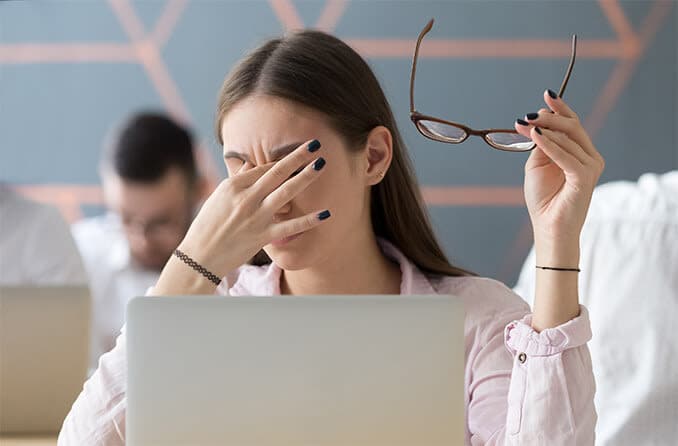What is asthenopia?
Asthenopia is the technical name for eye strain or eye fatigue. Computer vision syndrome (also called digital eye strain) and extended use of digital devices are leading causes of asthenopia. Eye discomfort, headache and blurred vision can all be symptoms of eye fatigue.
What are the symptoms of asthenopia?
If your eyes ache or burn after working on a computer or reading, you may be suffering from asthenopia. While this is not a medical disease, it can cause many symptoms that can decrease your quality of life.
In most cases, asthenopia symptoms are not associated with serious diseases. In some cases, eye aches and fatigue may be due to an underlying condition that needs treatment.
Computers and tablets are becoming increasingly common at work and school. More adults and children are experiencing eye fatigue and eye strain as a result. Technology in school has resulted in increased asthenopia in children.
You are at higher risk if your work or school requires that you spend a large part of most days focused on the computer. The symptoms begin sooner and last longer when your eyes do not have a chance to rest.
An individual may not realize that the eye discomfort they experience at work or school may be due to eye strain. Asthenopia symptoms may begin while you are working but can continue even afterward.
Although asthenopia is often due to near work, it can result from any activity that requires a long period of focused attention, such as driving.
Symptoms associated with asthenopia include:
Eye pain and soreness
Dry, burning irritated eyes
Blurry or double vision
Headaches and tiredness
Inability to focus
Asthenopia symptoms will be worse later in the day than in the morning when your eyes are fully rested.
READ MORE: How to help children avoid computer vision syndrome
What are the causes of asthenopia?
You can have healthy eyes and the correct prescription but still suffer from eye strain. This is because, like any other muscle in the body, the muscles of the eyes fatigue. If you need new glasses, or if a muscle balance issue also exists, the stress on the ocular system is even greater. This will lead to worse symptoms and a quicker onset of symptoms. The most common causes of asthenopia are:
Focusing at near for an extended time
The sustained effort of continuous accommodation or convergence causes strain. Computer use, reading, or a hobby such as crocheting or model building all need extended focus.
Ciliary muscles of the eye enable clear vision, but they can become fatigued under the strain of continuous accommodation. Accommodative insufficiency can worsen symptoms. Computer vision syndrome and prolonged periods of looking at smartphones are the most common causes of asthenopia.
Often, the rate at which you blink decreases while working on a computer. This can worsen symptoms of eye fatigue. People who have dry eyes are especially vulnerable to this.
Lighting that is too dim or too bright
Brighter lighting can relieve eye strain if a room is too dimly lit. But, excess glare from bright lighting can also cause eye fatigue. When working up close, be sure that the light is pointed toward your desk, not into your eyes. Working in natural soft light is often easier on the eyes than harsh, artificial lighting.
An imbalance of the eye muscles
If there is an imbalance of the muscles, the increased strain on the eyes to keep vision clear can cause eye fatigue. Blurry or double vision can also result.
People with heterophoria and convergence insufficiency commonly experience eye strain. Esophoria and exophoria are common binocular vision disorders. As the visual system is taxed, it becomes more difficult to maintain a clear image.
The constant demand on the accommodative system results in persistent symptoms of asthenopia. Vision therapy may be recommended by an eye doctor to strengthen the focusing muscles of the eye.
Uncorrected refractive error
Uncorrected astigmatism and farsightedness can cause a great deal of eye strain and fatigue. The onset of presbyopia can also cause symptoms. This is easily addressed with an updated pair of glasses prescribed by your eye doctor.
College students who are required to spend long periods of time studying and working on a computer are at high risk of asthenopia. It is important for them to maintain eye and vision health with yearly visits to the eye doctor.
Children are at high risk of asthenopia. They often do not realize that their vision is not as clear as it should be. They may experience eye strain while doing schoolwork and regard it as normal. The symptoms of asthenopia may cause them to have a difficult time focusing on their schoolwork. Staying up to date on a yearly eye exam is especially important for school-aged children.
SEE RELATED: Eye exams for children: Why they're important
How is asthenopia diagnosed?
If you are having symptoms of eye strain, the first step is to see an eye doctor to rule out potentially serious underlying conditions.
At your visit, your eye doctor will perform a thorough eye exam to determine the cause of your asthenopia. You will be asked when the symptoms are worse and what kind of symptoms you are experiencing.
Before going in to see your doctor, make a list of what your visual demands are during a typical day. Write down when you experience the greatest eye strain and what seems to relieve it. This will help your doctor provide the most appropriate course of treatment.
SEE RELATED: How computer glasses can ease digital eye strain
What is the treatment for asthenopia?
Your doctor may prescribe new glasses to address any visual issues. Underlying health conditions should also be treated. In addition, they may recommend technology adjustments or lifestyle changes.
Technology adjustments
Adjusting font and background color to increase comfort and readability.
Placing glare-reducing filters on computer screens.
Wearing designated computer glasses with a prescription for intermediate vision.
Using blue light filtering glasses that may make the screen more comfortable to view.
SEE RELATED: Computer ergonomics and healthy vision
Lifestyle changes
Applying artificial tears or warm compresses when eyes feel irritated and dry.
Taking visual breaks — an easy way to remember this is the 20-20-20 rule (every 20 minutes, for 20 seconds, look at something at least 20 feet away).
Optimizing the height of your desk, chair and screen to maintain comfortable posture.
Ensuring that your work desk is properly illuminated. Lighting should be bright but not too harsh. Light should be directed away from the eyes.
Reminding yourself to blink — even if you have to put a post-it on your screen.
Ensuring that you are getting an adequate amount of sleep and staying hydrated.
Maintaining proper air circulation and a comfortable indoor climate with a humidifier.
SEE RELATED: 10 Tips for Computer Eye Strain Relief
My work and hobbies require extended focus; will my asthenopia symptoms continue?
Once your eye doctor has identified the source of your asthenopia, you can take steps to relieve the symptoms. New glasses, devices to help with eye strain, font and color adjustments and vision therapy are all effective at relieving eye strain.
Diagnosing and treating asthenopia will allow you to once again focus comfortably on your computer, smartphone and hobbies.







